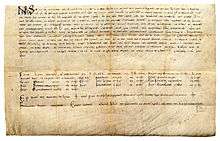Sancho IV of Navarre

Sancho IV Garcés (1039/40 – 4 June 1076),[1] called Sancho of Peñalén (Spanish: el de Peñalén) or Sancho the Noble (Spanish: el Noble), was the King of Navarre from 1054 to 1076.
Sancho was the eldest son and heir of García Sánchez III and his wife Estefanía. García was killed at the Battle of Atapuerca on 1 September 1054 during a war with the Kingdom of León. Sancho, who was then fourteen years of age, was proclaimed king by the army in the camp by the field of battle with the consent of the king of León, Ferdinand I, also his uncle.[2] Sancho's mother served as his regent until her death on 25 May 1058. Remaining faithful to her husband's policies, she continued to support the monastery of Santa María la Real of Nájera.
Soon after Sancho's accession, many lords in the west of the kingdom went over to the Leonese. Only Íñigo López, lord of Biscay, and Sancho Fortúnez, lord of Pancorbo, remained loyal. On 29 December 1062, Sancho and Ferdinand signed a treaty defining their shared border. Ferdinand was recognised as king of all Castile and Sancho's authority was recognised in the Rioja, Álava, Biscay, and implicitly Guipúzcoa.[3]
As king, Sancho received support from his other uncle, Kin Ramiro I of Aragon. Out of gratitude for "his friendship, his fidelity, his help and his council", Sancho gave Ramiro possession of Lerda, Undués and the castle of Sangüesa. These places were probably to be held as fiefs or in a similar arrangement. Beginning in 1060, Sancho put pressure on al-Muqtadir, king of Zaragoza, and exacted from him annual payments of tribute, parias.[3]
From 1065, he was in conflict with Castile, raised to a kingdom for Ferdinand's son Sancho the Strong. This culminated in the so-called War of the Three Sanchos (1067–1068). Years before, Sancho's father had managed to retain a series of frontier lands, including Bureba and Alta Rioja, which had been claimed by Ferdinand. Sancho the Strong sought to reconquer these lands for his kingdom. Faced with an invasion by his cousin the Castilian Sancho, The Navarrese Sancho asked for aid from his other cousin, Sancho of Aragón. But their forces were defeated by Sancho the Strong and his trusted alférez (supreme commander) El Cid, Sancho lost Bureba, Alta Rioja, and Álava to Sancho of Castile.
He was assassinated in Peñalén, whence his nickname, by a conspiracy headed by his brother Ramón Garcés (el Fratricida, the Fratricide) and his sister Ermesinda of Navarre. During a scheduled hunt, Sancho was forced from a cliff by his siblings. Upon his assassination, Navarre was invaded and ultimately partitioned between Sancho of Aragon and a third cousin, Alfonso VI of León and Castile. Alfonso occupied La Rioja and Sancho was proclaimed king in Pamplona.
Family

Sancho was married in 1068 to a Frenchwoman, Placencia,[4] and they had two sons, both named García:[5]
- García
- García Sánchez, who died in Toledo after 1092 and who was displaced by Sancho I of Aragón with the support of the Navarrese nobility who did not want to have a child-king.
With a slave named Ximena,[6] he fathered two children:
- Raimundo Sánchez, lord of Esquiroz
- Urraca Sánchez[7]
Notes
- ↑ Sancho IV, Encyclopedia Britannica.
- ↑ Narbaitz 2007, pp. 153–55.
- 1 2 Narbaitz 2007, pp. 153–.
- ↑ Reilly 1995, p. 71.
- ↑ It was a common practice in Navarre at that time to have more than one child with the same name. In 1092, at the Monastery of Valvanera, Garsea et alter Garsea, germani, filii Sanchii regis Nagerensis confirmed a charter.
- ↑ On 18 July 1071, in the documentation of the Cathedral of Pamplona, Sancho donated Esquiroz to his slave Jimena and their son Raimundo.
- ↑ In 1072, in a charter in the Monastery of Leyre, king Sancho entrusts the education of his daughter Urraca to the abbot of Larrasoaña, donating some property in the valley of Sardaraig.
Sources
- "Sancho IV (king of Navarre)". Encyclopedia Britannica Online. 2010. Retrieved 2010-03-25.
- Martín Duque, Ángel J. (2002). "Vasconia en la Alta Edad Media: Somera aproximación histórica". Príncipe de Viana. 63 (227): 871–908.
- Narbaitz, Pierre (2007). Navarra o cuando los vascos tenían reyes. Editorial Txalaparta.
- Reilly, Bernard F. (1995). The Contest of Christian and Muslim Spain 1031–1157. Blackwell Publishing.
| Preceded by García Sánchez III |
King of Navarre 1054–1076 |
Succeeded by Sancho V |
